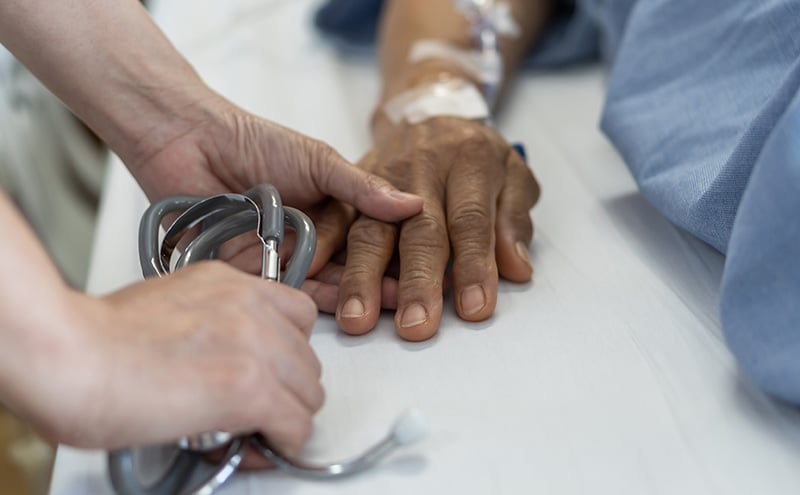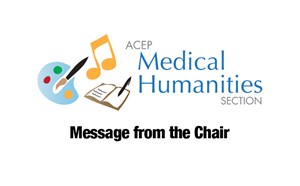
2020 Medical Humanities Section Writing Award Winner – Prose Category Edward Lew, MD, FACEP
Transference, Countertransference
By Edward Lew, MD, FACEP
My grandfather died. I remember removing the BiPAP mask and placing him on nasal cannula. I remember detaching the heart monitor and removing the pulse oximeter. I remember his delirium (he had told us to find the money hidden in his house – a treasure to be found). I remember how it started as one bloody stool that turned into transfusions triggering pulmonary edema. He would never recover. I remember rushing to conclude my post-residency housing search to get back. I remember calling my brother at night to take the earliest flight out. I remember making the end-of-life decision for my non-medical grandmother and father. And I remember his last breath.
As a third-year medical student, I had been taught about countertransference during a psychiatry rotation. It was this notion that, as physicians, we could somehow project our past emotions and wishes onto our own patients. At the time, this was portrayed as a medical sin – something that needed to be avoided. It would obscure our medical judgment. Indeed, my attendings had inferred we must be objective at all costs, at all times.
I finished that psychiatry rotation with honors. The long-lasting lesson learned was to listen to my patients but not let emotions seep into my assessments and plans.
I eventually gravitated towards emergency medicine. Its quick decision-making, its evidence-based approach, its acuteness, and its rapid admit or discharge mentality meshed with me. Throughout the residency, sympathy, empathy, and compassion were not priorities. With relatively brief patient encounters and “move-the-room” mentality, holding hands was an impediment. An exact approach to patients – methodic, scientific – resonated with me at that point in my training. It made me a stronger clinician.
Strength, however, I would learn, is not calculated by time to disposition or patients per hour. Strength is measured by the bonds between the patient and the physician. In a fleeting year as an attending, I have had many peri-death patients. This was different and the same. My grandfather unexpectedly came back to me.
On the gurney, a frail Chinese man struggled to breathe. Hypoxic, tachypneic, he needed intubation. His skinny frame outlined his failing muscles with each inspiration. I placed him on BiPAP, extending the inevitable. Metastatic cancer had destroyed his body. As I examined him carefully, I instinctively held his hand, as if I’d known him all my life. Our eyes had an understanding, and he nodded at me. Transference. Countertransference. I had hoped that I could soothe each agonizing gasp. I had hoped that I would remind him of someone caring, someone trusting – family.
His daughter arrived. She tearfully knew: This was the end. I remembered the feeling. The feeling that someone you loved would die. If it were not for machines, death would be minutes away. I also remembered the absolute catharsis of having family in the room. We discussed the importance of surrounding him with loved ones, and we agreed. We would strive to keep him alive until his soul could be warmed by family as his body became cold.
Hours and hours painfully passed as the emergency department continued as it does. Sons, daughters, family entered one by one until the time had come. I removed the BiPAP mask and placed him on a nasal cannula. I detached the heart monitor and removed the pulse oximeter. I ordered the morphine and stepped out of the room.
My metrics had not been met. It was well beyond my time to disposition. As loved ones left the room, we joined and shared tears. Although heartbreaking, they appreciated how right this moment was. They were thankful. I admitted this is what I would want – what he would want. The mutual experience was more powerful than any procedure or medication I could prescribe. I was with family.
I have learned that doctoring is more than science, evidence, therapies, and diagnoses. Early on, we are taught to strive to keep our life and our profession separate, without exceptions. But, when they inextricably collide, what should we do? The practice of medicine – the art of medicine– is informed by our lived experiences. Although it was ingrained early in my career to divorce myself from my personal emotions, I’ve discovered that they are incredible drivers of a humanistic practice. They deserve an equal weight in our decisions to the medical textbooks.
With each patient in the emergency department, I reflect on every encounter. I force myself to visualize the sobering eyes, to feel the gut-punch of imminent death, and to take solace in family warmth and palliation. How can we provide them comfort? What’s the best way to communicate end-of-life goals? What emotions does this evoke? For the patient? For the family? For me?
I have learned that we must recognize our countertransference, realize that we are not soulless, and appreciate our feelings. I hold more hands, sit on more trash bins to be at eye level, and weep more often now. I still see my grandfather occasionally in others, and I will continue to approach patients the same – with compassion inspired by my own experience. We should not deny our personal journeys from informing our medical decisions. Using them to power how we treat our patients and their families is not only meaningful, but also good medicine for the patient and the physician. Transference, countertransference.



